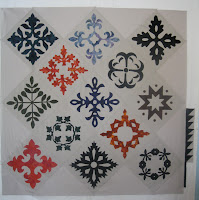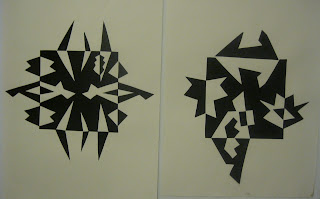Finally, I've carved out a day at home to sew. I'm treating myself with beginning a new project, a baby quilt that will be called for next month. I'm going to do "Big Dots" from Quilts Made Modern, a new book by Weeks Ringle and Bill Kerr of FunQuilts. The quilt will be about 20 big circles appliqued onto a solid field. I decided to use some of the hand-dyed fabric I made up this summer for the dots (rust to navy above), but I didn't have a large piece of an appropriate color for the field. I decided to dye up a new piece for this, choosing a pale peachy orange from the sample book from Carol Soderlund's class. I was dubious about whether this would work, because one is always told that dye needs 70 degrees or warmer to bond with the fabric, and I don't keep my house that warm. Some people warm up the container by putting it on a heating pad, but I didn't want to bother with that. Frieda Anderson, who taught at my local guild in October, had encouraged me not to worry about the temperature--she dyes through the winter in her basement, which is definitely not 70 degrees. So I went ahead and tried it out, and it worked beautifully. The resulting color is perhaps a slight bit paler than the sample I was aiming for, but that's perfectly fine for this project. Success!
The directions for this project recommend machine applique for the dots (about 7" and 9" in diameter). I've always done needle-turn hand applique before, but decided to challenge myself and learn the technique recommended in the book, which involves using freezer paper templates, basting around the edge and pulling the thread ends to turn under the edge, and then using zig-zag stitch on the machine to sew the dot to the field. The "freezer paper and pull-the-thread" technique is quite nifty, and gives a really smooth edge. Here's a sample I did with some other fabrics.
I tried two different machine stitches. To the left of the arrow is a blind-hem stitch; to the right is a narrow zig zag.
I'm not sure which I prefer. The zigzag lays a little flatter, but the blind stitch is less visible (except for that run of stitches around the outside of the circle). Of course I could make it really invisible by switching to hand-stitching. Any advice on which you think looks better? I'll also be machine stitching the quilt once it's put together, so that will be another layer of stitching.
January 27, 2011
January 16, 2011
Travel appliqué put together--and borders?

I decided to do the "on point" diagonal setting for these blocks, but to take a row off at the bottom so that I didn't have to make more blocks. The top as is comes to 64" square; I'll add a couple of borders, which will make it a good size for a throw on our couch. The gray used for the setting triangles and corners is a little lighter than that used for the squares--an accident of different dye lots for this Kona cotton, but I actually like the slight contrast. This arrangement leaves me with a couple of "orphan blocks," but I have good uses for them. One of them was not a favorite; I can use it to do some trial quilting. The other was a much more intricate design than the rest, and in a different style. I think I'll put some borders on it (below) and make it into a wall hanging; the single block is 15" square:

Then I auditioned a couple of different border possibilities: a sawtooth border and a plain strip (one above the other in photo on left below). Better to combine them--first a plain strip and then sawtooth outside that one (center). I also tried out a dogtooth design (the "mountains" on right), but like the sawtooth better.
Next is one of my least favorite parts of quilting--doing the math in order to figure out how to get the sawtooth triangles to fit neatly around. This is what usually keeps me from doing anything except the simplest borders! But since I'll be inserting a plain border before the sawtooth one, I should be able to size that border in such a way that the math for the sawtooth pieces comes out. This is a task that must wait until I'm feeling sharp. Now, if my mother (former math teacher) were alive, I could give her the measurements and she would enjoy working it out!
January 11, 2011
Travel appliqué
I like to carry appliqué with me when I travel, and a long trip last month--almost four weeks away from home--gave me a chance to finish up a few more blocks in this very long-term project; I only work on it when I'm travelling. These blocks will be trimmed to 15"; I have one more basted up that I'm still working on. If I do a diagonal set like this, I'll need to make six more blocks; the side triangles will probably be plain grey. If I do a straight set as below (to which I would probably add sashing), I just need the one more that's in progress. Cutwork applique like this works really well for travelling, as I can baste the whole block together before I leave home and not worry about losing little pieces. I didn't do a lot of planning in the blocks--just picked designs I liked. Not sure this ends up being the best design overall, but I got a lot of pleasure in the making of it.
Being without a sewing machine for a month, and knowing I had to limit how much hand-sewing I did (because of the pain I've had in my hand), I decided this would be a good time to work through the Notan design exercises in the book below, something I've been wanting to do for a while. One of the weeks away was in a rented house in Hawaii (the Big Island), a beautiful, quiet place up a mountain, in rainforest landscape. It was lovely to sit out on the lanai and cut and paste paper.
Here are a couple of tries at the "expansion of the square" exercise.
Here's the house we rented, for a very reasonable price.
This is the back yard. I spent some very pleasant time sitting out here with my applique or a book.I would highly recommend this particular rental, which you can find here: http://www.vrbo.com/61570.
Subscribe to:
Comments (Atom)













